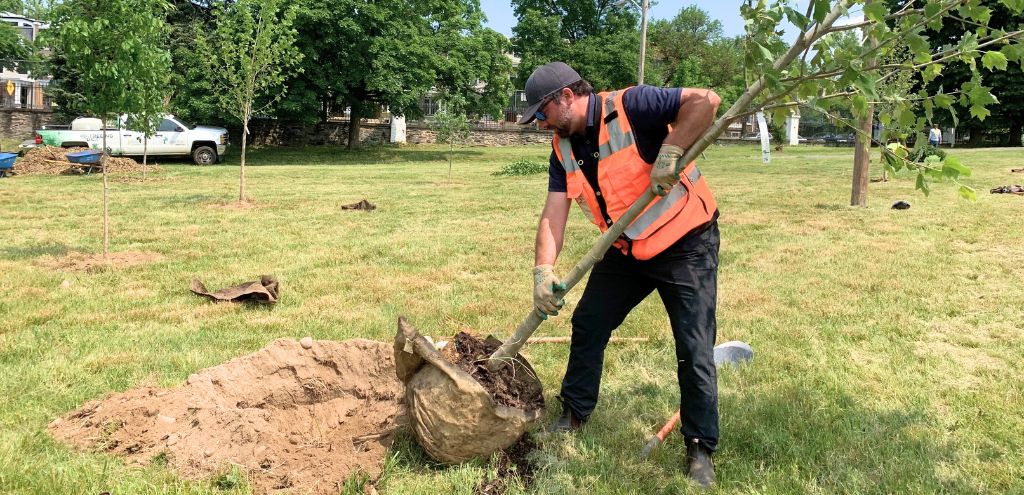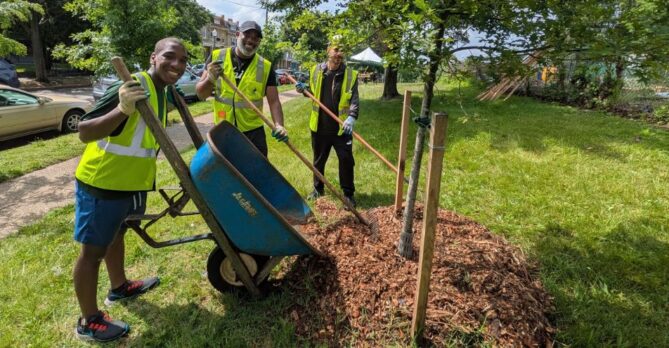Robert Shaut, current Director of Tree Operations and incoming Chief Operating Officer, recently chatted about DC’s urban trees with Kathy Jentz, editor of Washington Gardener Magazine and host of the GardenDC Podcast. Specifically, they discussed the selection of tree species in our urban environment and what it takes to care for them.

“Top Urban Trees” with the GardenDC Podcast
In this episode, our Director of Tree Operations, Rob Shaut, talks about species of trees that can survive in an urban environment.
During their conversation, Rob and Kathy talk about some of Casey Trees’ guiding principles and our approach to urban forestry, which emphasizes the careful selection and placement of trees to maximize their benefits and ensure their long-term health and suitability within the urban environment.
Rob and Kathy also discuss some of their personal favorites:
Kathy Jentz: “Let’s talk about urban trees, and some of our personal favorites – those that have withstood some of those urban trials that urban trees go through – which includes pollution, root competition, drought, especially in the last year or so, and other adverse effects. And then some trees can flourish in those conditions. What are your favorites, Rob?”
Rob Shaut: “We talk a lot about ‘urban warriors,’ because of all of those conditions you alluded to. [The city] is almost like a non-native setting. In the mid-Atlantic, the native trees – you think of certain trees that are native but might have a hard time in urban settings. Like Dogwood – they want to be dappled shade, nice loamy soil. That’s not really what you find in urban settings. You can find that, perhaps, in a residential setting, but much more challenging in a right-of-way, a street tree setting between the curb and the sidewalk…”

Rob also mentions some of his favorites, including species of Oaks, Elms, Cherries, Gingko, Catalpa, Honeylocust, Magnolias, Serviceberry, Yellowwood, Redbuds, Sweetgum, and more. But he goes on to say it’s not only about planting, but an emphasis on tree care, ensuring the trees that are planted thrive:
“There’s a lot of funding for [tree] installation, very little funding for maintenance. And it’s just the biggest part of cultivating a garden or plants – is the long term. And that’s what you kind of have to fall in love with to really have a long tenure in this industry… seeing the trees react to the pruning, making sure you’re tidying up or harvesting the fruit, or doing various things that may be seen a nuisance but it’s really just part of what you’re doing. The pruning and maintenance is so big, and watering to allow the tree to survive and continue to succeed. So the maintenance component that you mentioned is always top of mind for us at Casey Trees. Because what is a tree that doesn’t make it through the summer drought? It’s really trying to put it on this trajectory for success for decades and hopefully a century, and so much of that is within the first one to 10 years – watering for establishment, pruning it to have success, and then that tree can really thrive for decades”.
You can listen to their full conversation here. If you’re looking for more content, revisit GardenDC’s podcast episode about invasive plants featuring our horticulturist and landscape architect, Maddie Hoagland-Hanson.
